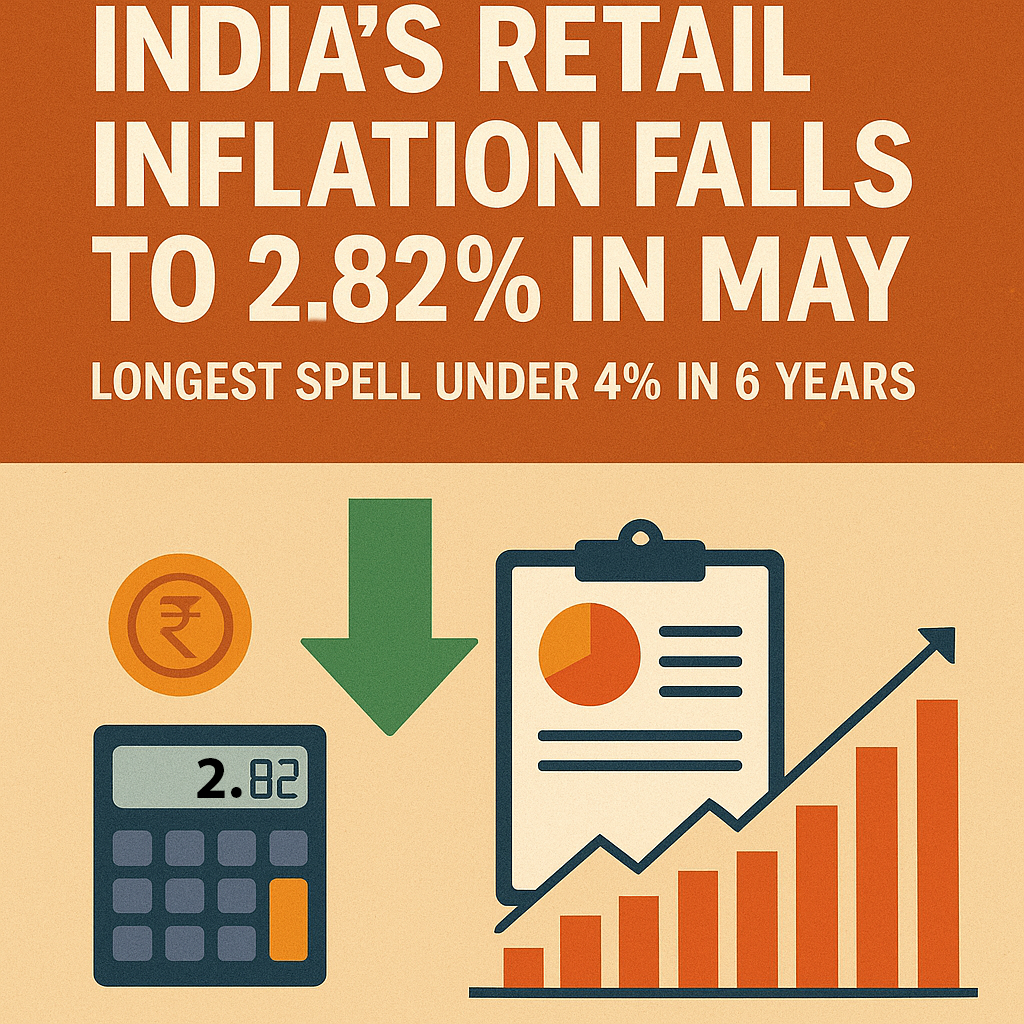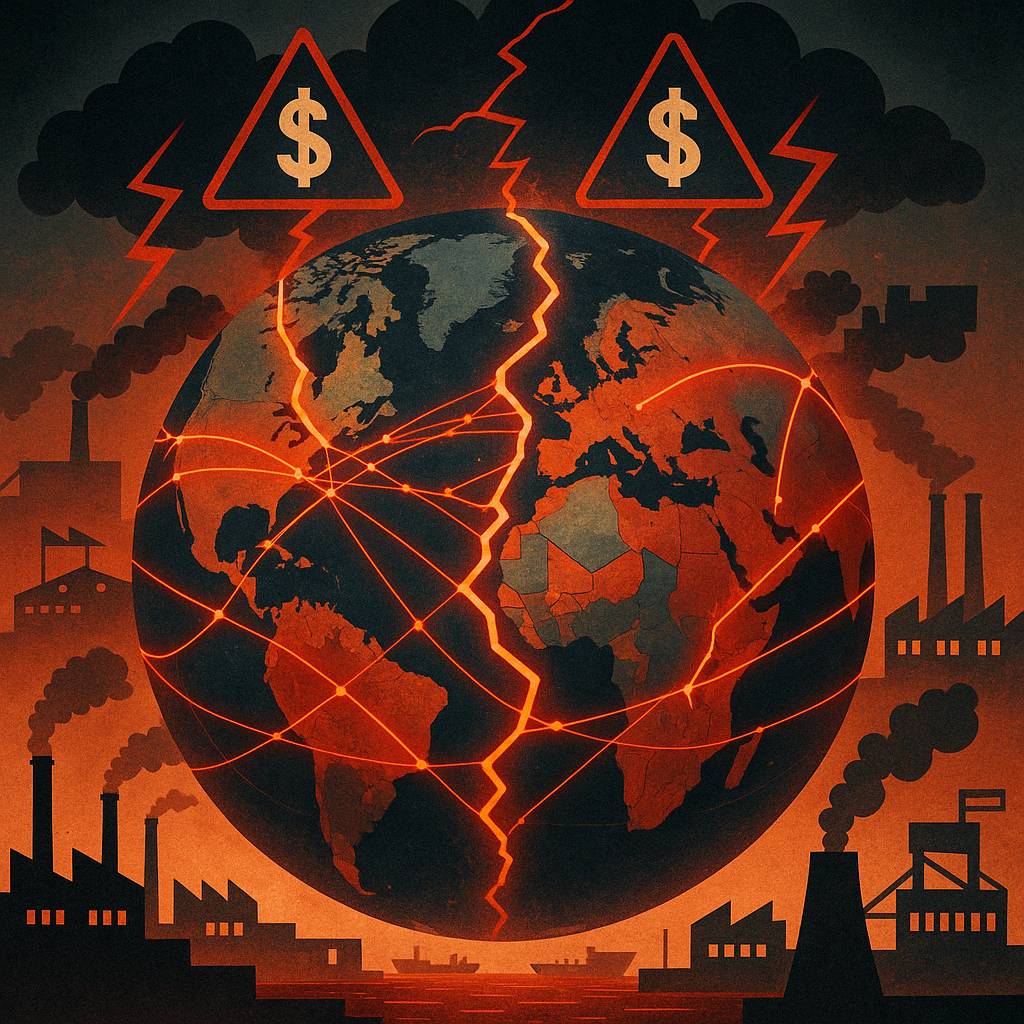
🧭June 12, 2025 Post 2: India’s Retail Inflation Falls to 2.82% in May | High Quality Mains Essay | Prelims MCQs
India’s Retail Inflation Falls to 2.82% in May

NATIONAL
📅 Post Date: June 12, 2025
📘 Thematic Focus: Economy | Inflation Trends | Monetary Policy
🌿 Opening Whisper
“When prices pause, economies breathe—and households begin to dream again.”
🔍 Key Highlights
- India’s Consumer Price Index (CPI)-based inflation for May 2025 fell to 2.82%, marking the lowest level since 2018.
- This is the fourth consecutive month CPI has stayed under the RBI’s upper tolerance of 4%, marking the longest such spell in six years.
- The moderation was driven by lower prices in vegetables, fuel, and transport, while core inflation remained stable.
- The dip supports the RBI’s recent 50 basis point repo rate cut, adding momentum to pro-growth monetary policy.
- Economists suggest a continued dovish stance, especially with global commodity prices stable and domestic demand recovering gradually.
- However, concerns remain over food inflation volatility, especially in pulses and cereals, ahead of the monsoon.
📘 Concept Explainer: What is CPI Inflation and Why Does It Matter?
- The Consumer Price Index (CPI) tracks changes in retail prices of a basket of goods consumed by households.
- It is the benchmark measure used by the RBI to anchor its monetary policy, targeting 4% inflation with a 2% margin.
- Sustained moderation in CPI reflects macroeconomic stability, better supply-side management, and moderation in demand-push pressures.
- Lower inflation boosts real income, eases borrowing costs, and stimulates investment in the economy.
🧭 GS Mains Mapping
- GS Paper 3 – Indian Economy | Growth and Inflation | Monetary Policy
- GS Paper 2 – Government Interventions in Food and Energy Sectors
💭 A Thought Spark — by IAS Monk
“Inflation isn’t just a number; it is the quiet storm that whispers into every wallet. To tame it is to restore the poetry of the ordinary household.”
High Quality Mains Essay For Practice :
Word Limit 1000-1200
Inflation Under Control: India’s Price Stability Moment and What It Signals
Introduction
For a country where food prices ignite political debates and fuel prices sway consumer confidence, inflation is not just an economic indicator—it’s a social thermometer. On June 12, 2025, India recorded a Consumer Price Index (CPI)-based retail inflation rate of 2.82% for May, marking the lowest level in over six years and sustaining a remarkable four-month stretch below the Reserve Bank of India’s (RBI) upper tolerance limit of 4%. This milestone signals a rare phase of price stability in India’s recent macroeconomic history.
In a world reeling from post-pandemic inflation spikes and global supply chain disruptions, India’s inflation performance stands out as a policy victory, enabled by coordinated monetary discipline, improved supply-side logistics, and softening global commodity prices. This essay explores the underlying causes, implications for monetary and fiscal policy, sectoral dynamics, and lessons for long-term inflation targeting.
Understanding CPI and Its Importance
What is the Consumer Price Index?
The Consumer Price Index (CPI) measures the average change in prices paid by consumers for a basket of goods and services, such as food, fuel, transport, housing, and clothing. It is:
- The primary inflation metric used by the RBI.
- Crucial for determining interest rates, real wage growth, and household consumption behavior.
- Segregated into headline inflation (all items) and core inflation (excluding food and fuel, which are volatile).
India’s inflation target, set under the Monetary Policy Framework Agreement, is 4% with a tolerance band of ±2%.
What Led to the Decline in May 2025 CPI?
1. Falling Food Prices
- Vegetable prices dropped significantly due to bumper harvests in the rabi season and improved logistics.
- Perishable items like tomatoes, onions, and potatoes saw price corrections after last year’s spike.
- While pulses and cereals remain high, their relative weight in the CPI basket is lower than vegetables.
2. Stable Fuel Costs
- Global crude oil prices have remained below $70 per barrel for much of Q2 2025.
- India’s domestic fuel adjustments and cut in excise duties helped ease fuel inflation pressures.
3. Effective Monetary Policy
- The RBI’s 100 bps cumulative repo rate cut over the last two months has begun to transmit liquidity into productive sectors.
- Interest rates on housing and auto loans have fallen, encouraging investment without overheating consumption.
4. Base Effect
- May 2024 had unusually high inflation (6.94%) due to war-related crude and logistics shocks. The current moderation benefits from a favorable base effect.
Economic and Policy Implications
A. Room for Continued Monetary Easing
- With inflation under 3%, RBI has a rare policy window to stimulate growth through rate reductions or liquidity expansion.
- A repo rate reduction could further ease credit conditions and lower cost of borrowing for MSMEs, agriculture, and consumers.
B. Improved Household Confidence
- Low inflation boosts real purchasing power.
- Fixed income households and pensioners benefit from reduced price volatility.
- Consumption in sectors like FMCG, consumer durables, and services could increase.
C. Favorable Conditions for Capex
- Lower interest rates improve the viability of long-gestation capital expenditure projects.
- Government capex under PM Gati Shakti and state infra push will face less crowding-out risk from inflation-driven borrowing.
D. Bond Market Stability
- Bond yields are expected to stabilize or fall, creating room for cheaper government borrowing.
- Foreign Portfolio Investors (FPIs) may increase exposure to Indian debt, improving forex reserves.
Risks and Caveats
Despite the positive trend, there are key areas of concern:
1. Food Inflation Risks Remain
- Prices of pulses, milk, and edible oil remain sticky.
- A delayed or uneven monsoon could affect kharif sowing, reversing recent gains.
2. Imported Inflation via Currency Depreciation
- Any weakening of the rupee (due to Fed hikes or geopolitical shocks) could import inflation in energy and electronics.
3. Core Inflation Flattening
- While headline inflation is down, core inflation remains around 4%, indicating embedded service-sector pricing pressures.
4. Global Crude Oil Uncertainty
- Escalating tensions in West Asia or OPEC production cuts could abruptly push fuel prices higher.
Lessons from Global Trends
India’s inflation moderation contrasts with challenges faced elsewhere:
- The US Federal Reserve is grappling with sticky core inflation above 3.5% despite rate hikes.
- The Eurozone faces dual inflationary pressures from energy and wage growth.
- Emerging markets like Argentina, Turkey, and Egypt continue to see double-digit inflation.
India’s success demonstrates that targeted food interventions, moderate rate adjustments, and macroprudential coordination can stabilize prices in a developing economy context.
Government and RBI’s Coordination: A Key Factor
Supply-Side Measures
- ONDC (Open Network for Digital Commerce) and eNAM have improved food supply chains.
- Buffer stock management by FCI and Nafed helped smooth pulses and grain prices.
Fiscal Responsibility
- Despite an election year, the Union Budget 2025–26 avoided populist giveaways and maintained the fiscal deficit below 5.2%.
- Controlled subsidy spend kept fiscal-induced inflation in check.
Communication and Credibility
- RBI’s transparent inflation forecasts, coupled with its timely repo rate adjustments, bolstered public trust in policy stability.
Way Forward: Sustaining Price Stability
1. Strengthening Agri Supply Chains
- Expand cold storage and real-time price monitoring through the AgriStack ecosystem.
- Support contract farming and decentralized procurement to reduce market bottlenecks.
2. Diversify Energy Sources
- Push for biofuels, green hydrogen, and rooftop solar to reduce fossil fuel import dependence.
3. Deepen Market Monitoring
- Expand the inflation forecasting unit in RBI with AI-powered data analytics to track rural, urban, and real-time consumption patterns.
4. Safeguard Against Complacency
- RBI must not overreact with aggressive rate cuts; vigilance is key as inflation can reverse swiftly.
Conclusion
India’s 2.82% retail inflation reading for May 2025 is not just a data point—it’s a narrative shift. It reflects the coming of age of India’s monetary–fiscal coordination, supported by a digital, transparent, and increasingly responsive economic ecosystem. For households, it offers relief. For businesses, a window of opportunity. And for policymakers, a rare moment of stability.
But the challenge lies in staying grounded. As history shows, inflation has a way of rearing its head the moment attention fades. The RBI must therefore act not out of celebration—but out of cautious optimism. Because taming inflation is not a one-time feat—it is a continuous dance of trust, data, and discipline.
Target IAS-26: Daily MCQs :
📌 Prelims Practice MCQs
Topic: Inflation
MCQ 1 – Type 1: How many of the above statements are correct?
Consider the following statements regarding India’s retail inflation in May 2025:
1. India’s CPI-based inflation in May 2025 was recorded at 2.82%, the lowest in over six years.
2. The RBI targets inflation at 6% with a tolerance band of ±2%.
3. The decline in inflation was mainly driven by food, fuel, and transport prices.
4. Retail inflation has remained below 4% for four consecutive months.
How many of the above statements are correct?
A) Only two
B) Only three
C) All four
D) Only one
🌀 Didn’t get it? Click here (▸) for the Correct Answer & Explanation
✅ Correct Answer: B) Only three
🧠 Explanation:
•1) ✅ True – The May 2025 inflation rate was 2.82%, the lowest since 2018.
•2) ❌ False – RBI’s inflation target is 4% ±2%, not 6%.
•3) ✅ True – Food, fuel, and transport categories moderated.
•4) ✅ True – Inflation has stayed below 4% for four straight months.
MCQ 2 – Type 2: Two Statements Based
Consider the following two statements:
1. Low inflation boosts real purchasing power and encourages investment.
2. Core inflation includes food and fuel prices.
Which of the above statements is/are correct?
A) Only 1 is correct
B) Only 2 is correct
C) Both are correct
D) Neither is correct
🌀 Didn’t get it? Click here (▸) for the Correct Answer & Explanation
✅ Correct Answer: A) Only 1 is correct
🧠 Explanation:
•1) ✅ True – Lower inflation improves real income and supports consumption.
•2) ❌ False – Core inflation excludes food and fuel, which are volatile.
MCQ 3 – Type 3: Which of the statements is/are correct?
Which of the following factors contributed to the decline in India’s CPI inflation in May 2025?
1. Bumper harvests in the rabi season
2. Stable global crude oil prices
3. Sharp increase in service-sector wage inflation
4. Favorable base effect from May 2024
Select the correct answer using the code below:
A) 1, 2 and 4 only
B) 2 and 3 only
C) 1 and 3 only
D) 1, 2, 3 and 4
🌀 Didn’t get it? Click here (▸) for the Correct Answer & Explanation
✅ Correct Answer: A) 1, 2 and 4 only
🧠 Explanation:
•1) ✅ True – Better harvests reduced vegetable prices.
•2) ✅ True – Global crude prices remained soft.
•3) ❌ False – Wage inflation in services did not drive down CPI.
•4) ✅ True – Last year’s high base helped in comparative moderation.
MCQ 4 – Type 4: Direct Fact
What is the current inflation target for the Reserve Bank of India as per the Monetary Policy Framework?
A) 6% with ±1% margin
B) 4% with ±2% margin
C) 5% with ±1% margin
D) 3% with ±2% margin
🌀 Didn’t get it? Click here (▸) for the Correct Answer & Explanation.
✅ Correct Answer: B) 4% with ±2% margin
🧠 Explanation:
•India’s formal inflation targeting framework mandates the RBI to keep CPI inflation at 4%, with a tolerance band of 2 percentage points on either side.


















